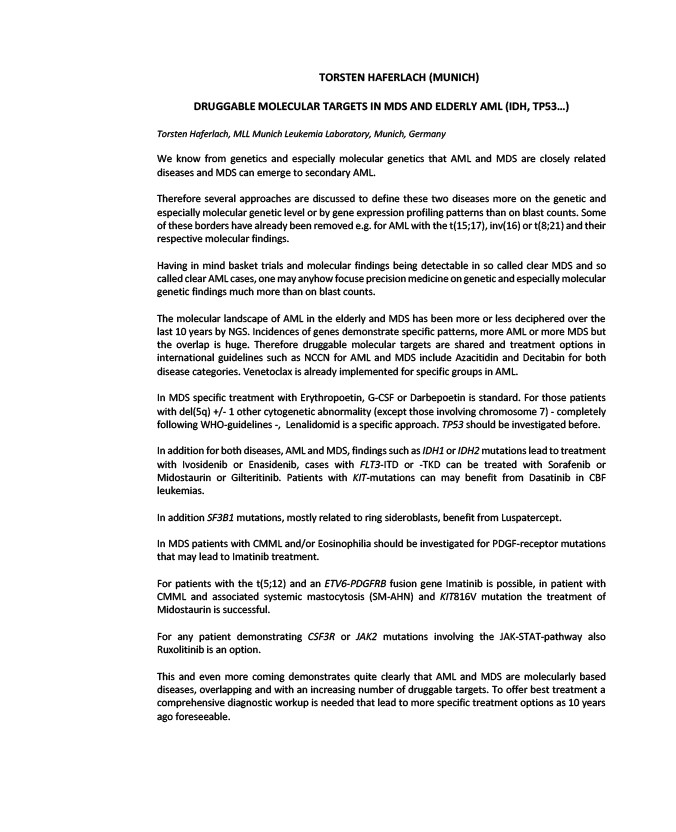
TORSTEN HAFERLACH (MUNICH)
DRUGGABLE MOLECULAR TARGETS IN MDS AND ELDERLY AML (IDH, TP53…)
Torsten Haferlach, MLL Munich Leukemia Laboratory, Munich, Germany
We know from genetics and especially molecular genetics that AML and MDS are closely related
diseases and MDS can emerge to secondary AML.
Therefore several approaches are discussed to define these two diseases more on the genetic and
especially molecular genetic level or by gene expression profiling patterns than on blast counts. Some
of these borders have already been removed e.g. for AML with the t(15;17), inv(16) or t(8;21) and their
respective molecular findings.
Having in mind basket trials and molecular findings being detectable in so called clear MDS and so
called clear AML cases, one may anyhow focuse precision medicine on genetic and especially molecular
genetic findings much more than on blast counts.
The molecular landscape of AML in the elderly and MDS has been more or less deciphered over the
last 10 years by NGS. Incidences of genes demonstrate specific patterns, more AML or more MDS but
the overlap is huge. Therefore druggable molecular targets are shared and treatment options in
international guidelines such as NCCN for AML and MDS include Azacitidin and Decitabin for both
disease categories. Venetoclax is already implemented for specific groups in AML.
In MDS specific treatment with Erythropoetin, G-CSF or Darbepoetin is standard. For those patients
with del(5q) +/- 1 other cytogenetic abnormality (except those involving chromosome 7) - completely
following WHO-guidelines -, Lenalidomid is a specific approach. TP53 should be investigated before.
In addition for both diseases, AML and MDS, findings such as IDH1 or IDH2 mutations lead to treatment
with Ivosidenib or Enasidenib, cases with FLT3-ITD or -TKD can be treated with Sorafenib or
Midostaurin or Gilteritinib. Patients with KIT-mutations can may benefit from Dasatinib in CBF
leukemias.
In addition SF3B1 mutations, mostly related to ring sideroblasts, benefit from Luspatercept.
In MDS patients with CMML and/or Eosinophilia should be investigated for PDGF-receptor mutations
that may lead to Imatinib treatment.
For patients with the t(5;12) and an ETV6-PDGFRB fusion gene Imatinib is possible, in patient with
CMML and associated systemic mastocytosis (SM-AHN) and KIT816V mutation the treatment of
Midostaurin is successful.
For any patient demonstrating CSF3R or JAK2 mutations involving the JAK-STAT-pathway also
Ruxolitinib is an option.
This and even more coming demonstrates quite clearly that AML and MDS are molecularly based
diseases, overlapping and with an increasing number of druggable targets. To offer best treatment a
comprehensive diagnostic workup is needed that lead to more specific treatment options as 10 years
ago foreseeable.